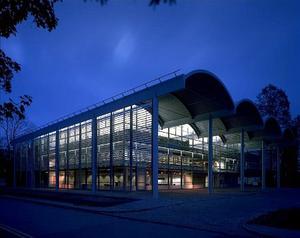In the trenchesAutonomous vehicles to map battle environments
War is always accompanied by the fog of war; to pierce that fog, researchers at Cranfield University are working on developing swarms of autonomous military vehicles capable of sharing and overlapping video images to create high-resolution 3D panoramic scenes of dangerous battlefield areas

Cranfield University campus, Bedfordshire, U.K. // Source: fosterandpartners.com
Swarms of autonomous military vehicles capable of sharing and overlapping video images to create high-resolution 3D panoramic scenes may one day be deployed to survey dangerous battlefield areas. This is the goal of a 3-year Bedfordshire, United Kingdom-based Cranfield University research program supported by BAE Systems.
Principal investigator Nabil Aouf, a researcher at Cranfield Defense and Security, told the Engineer that the project follows up work the university did last year with BAE Systems on developing a single autonomous vehicle capable of overlapping high-resolution video images — a process known as mosaicing — from multiple on-board cameras.
According to Aouf, the goal now is to make a group of up to ten of these vehicles share and overlap mosaiced video images. “High-resolution video mosaicing based on co-operative vehicles will not only offer clearer and wider 2D and 3D scene views, but it will also help the autonomy of these ground vehicles in terms of navigation, obstacle avoidance and their precision.”
Aouf said that video mosaicing is an important tool for autonomous vehicles in many applications such as land surveillance, military operations and disaster monitoring. These scenarios often require that images offer 3D information, a wide field of view and different viewing directions.
This is because objects seen within acquired videos tend to move quickly through the viewing stream. Therefore a wider view of a scene can help identify objects of interest.
Initial testing of the technology will involve a mobile robotic setup at Cranfield’s laboratories. Aouf also plans to use BAE Systems’ facilities to collect data from the company’s already available ground vehicles and validate the proposed work on more sophisticated real scenarios.
A software and hardware prototype of the technology should be ready for demonstration by the end of the project, he added.
If testing of the prototype is successful, Aouf said BAE Systems will be taking up the technology and deploying it on the battlefield sometime in the near future.
